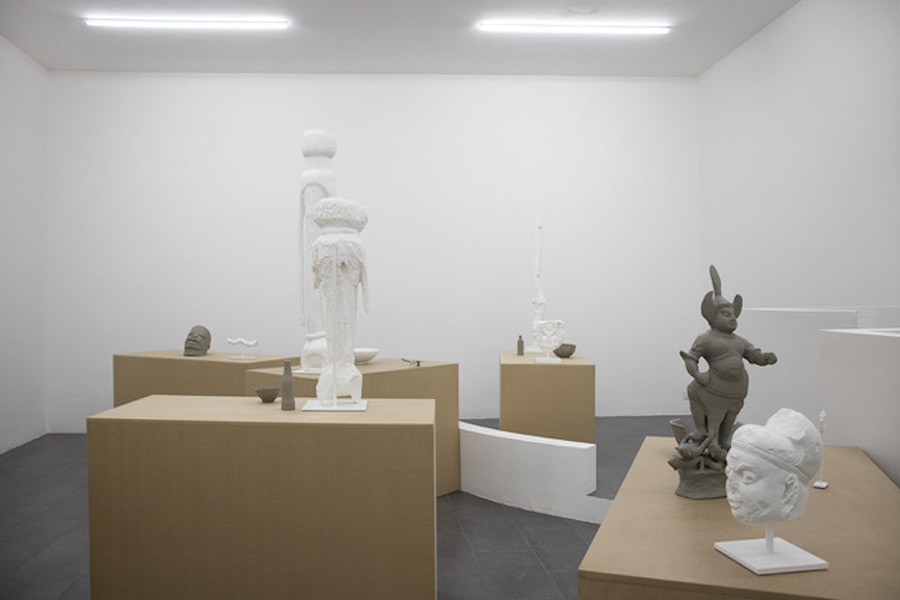
English text below
Gaylen Gerber | Galerie Emanuel Layr
Il Kintsugi è una pratica giapponese che consiste nell’aggiustamento di vasellame rotto mediante l’utilizzo dell’oro come collante. Ne ha parlato anche Sophie Calle in riferimento al suo lavoro Douleure Exquise, in cui confronta il dolore causato dall’abbandono da parte del suo amante con i dolori più forti che ha chiesto di farsi raccontare da amici, conoscenti o estranei. Lei dice che questa focalizzazione sul dolore, portandolo in primo piano, lo rende prezioso e utile per una crescita interiore. Le ferite, per guarire dentro di noi, devono vedersi, le dobbiamo vedere e non dobbiamo avere vergogna che gli altri le possano vedere.
Il Kintusgi riassume e materializza questo discorso, rendendo preziose le rotture di un vaso, anzi, impreziosendo il vaso stesso proprio a partire da quelle fessure. In questo caso, d’altra parte, il vaso rotto andrà ad assumere più valore rispetto a quello integro. Non è poi forse il valore della storia? Il tempo non distrugge e, distruggendo, crea? Non è vero che la vita, dando tutto, allo stesso tempo tutto toglie? La nascita non ha in sé il dolore e la morte? Cosa succede se tutto questo, rappresentato per esempio da un vaso giapponese firmato Nonomura Ninsei, del periodo Edo, viene ricoperto con della pittura grigia? Se tutto viene eliminato?
È quello che ha fatto Gaylen Gerber con l’opera “Support n. d.” presente ora nella sua personale alla Emanuel Layr di Roma. In mostra riconosciamo, individuando la forma o leggendo le didascalie, oggetti e artefatti pieni di storia e trasudanti iconografie.
C’è un pezzo di tazza del XI secolo; una tazza Samanid con l’inscrizione Kufic che recita “L’invidia è segno di povertà”, proveniente dal nord-est dell’Iran, anch’esso del XI secolo; una lattina del nostro tempo; un pezzo di architrave del XIII secolo proveniente dalla Cambogia, con dipinto Kala d’Angkor; una bottiglia di CocaCola. Tutto questo, che solo per le date e i luoghi d’origine si ricolma di significati e valori socio-culturali propri, viene cancellato attraverso la copertura di tutta la superficie mediante pittura grigia (come il pavimento della galleria, e del White Cube generico) o bianca (come le relative pareti).
La sedimentazione storica è cancellata dal gesto di un artista che nel XXI secolo si impossessa della storia che lo ha preceduto e degli scenari semantici e visivi che questa assume, la cancella in un luogo espositivo e attraverso i materiali che ne sono la rappresentazione, adagiando il monocromo come passaggio imprescindibile della storia e come azzeramento di spazio e tempo su ciò che il tempo lo ha per davvero, sia in quanto età, sia in quanto significato, sia in quanto società.

Gaylen Gerber | Galerie Emanuel Layr
Untill 17 February 2018
An American artist once asserted The great force of history comes from the fact that we carry it within us, are unconsciously controlled by it in many ways, and history is literally present in all that we do. 1 In this exhibition Gerber presents a number of artworks that press the relationship between the loss of traditional orientations and the oscillating sense of joie de vivre that often remains and in doing so he addresses the ways in which we perceive expression and understand established records.
Gerber s work relies on other artworks or artifacts and our sense of the history associated with them for much of its meaning. is work has long focused on the normative aspects of visual language: the way that we, as part of a shared culture, accept certain forms, colors and situations as institutional, or we take them for granted as impartial common ground. These visual norms act as grounds for all other forms of expression and we use them to register difference and create meaning. In some instances Gerber’s work has literally been the ground for other artists’ expression and in turn, he also uses other artists’ work as a normative ground against which his, and our own expressions can be recognized. As a result, everything in the exhibition is acknowledged as alternately both support and expression.
In Gerber’s Supports the original representation has been replaced with a homogeneous value. For example, the polychrome pictorial glazed surface that helped define the Kashiki bowl from the late Tokugawa or Edo Period Japan has been replaced by an alternate surface. The same is true for Support, a sādhu trumpet from late 19th or early 20th century Nepal, leaving just the homogeneous value of the painted surface visible. In both instances, the everyday is reaffirmed but the implications are existential. The associations of this surface are explicit in the history of the monochrome and alternate aspects of the Supports become readily apparent.
The result is an inversion of established ideas of art as a place to locate history within a particular context. Artworks and artifacts that are most often seen as records of the past: a Lokapala guardian figure from the Tang Dynasty in China; an Impossible Bottle from the 20th century United States; a drug spatula from the Chimu culture in Northern Peru, are understood in the moment of their perception. The power that artworks and artifacts from the past have to evoke delight, distress, empathy – a range of emotions – is a reflection of their continued effectiveness, and because of the reversal of the figure and ground all of the Supports share a standard surface that also functions to reflect a clear image not only of our relationship to the past but of the present. (press release)
1 James Baldwin, The Price of the Ticket: Collected Nonfiction, 1948-1985










